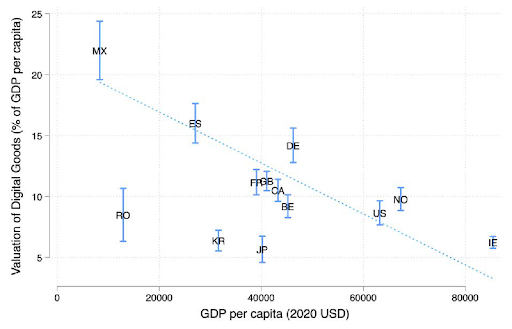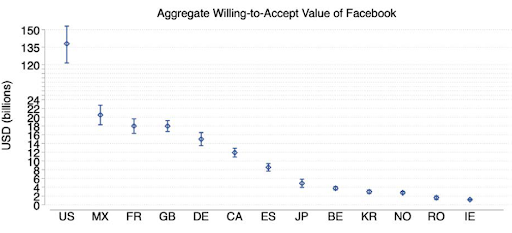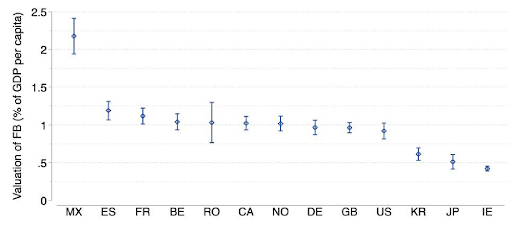Digital goods as social equalizers
How digital goods alleviate welfare inequality within and across countries around the world
A recent NBER working paper on the impact of digital goods underscores their potential as powerful tools for social good. A survey experiment reveals a higher valuation of digital goods among lower-income users and countries, implying that the free availability of these goods may break down barriers and enhance access to essential services and information.
A new NBER working paper by Erik Brynjolfsson and co-authors addresses longstanding econometric challenges in calculating the gains from digital goods by conducting large-scale incentivized choice experiments involving nearly 40,000 representative users across 13 countries who engage with the Facebook digital service. The scale of this study allows comprehensive estimation of the welfare gains associated with 10 popular digital services (Facebook, Twitter, Instagram, WhatsApp, Snapchat, TikTok, Google Search, Google Maps, YouTube, and Amazon Shopping), revealing staggering results.
Surveying the Digital Landscape: A Quest for Nuanced Insights
The transformative impact of digital technologies on our daily lives is undeniable, shaping how we connect, consume, and engage with the world. However, measuring the economic gains from the digital revolution poses a unique set of challenges. Traditional metrics such as GDP and productivity may fail to capturing the true value generated by digital goods, many of which are offered at no cost to consumers. This discrepancy is captured by the stagnation of the officially measured size of the information sector in relation to total GDP. This gap has motivated researchers to innovate novel ways to measure the welfare effects of digital goods.

Figure 1: Association between GDP per capita and Facebook users’ valuation of 10 digital goods (% GDP per capita).
Source: Brynjolfsson et al. (2023)
In this context, Brynjolfsson et al. use experimental methods to calculate how much digital goods contribute to the lives of people around the world. The authors surveyed 39,717 Facebook users across 13 countries on the Facebook internal survey platform, with their survey comprising two integral components, each designed to gauge distinct aspects of user preferences and valuations for 10 popular services.
The first component leverages a best–worst scaling approach to measure the hypothetical willingness-to-accept for various digital goods. This powerful technique captures the relative importance of different attributes or items, offering a nuanced understanding of user preferences and perceived value. The second component delves into the practical side of user valuations, focusing on Facebook itself. In an incentivized willingness-to-accept setup, respondents faced choices related to their acceptance or rejection of Facebook under specific conditions, capturing real-world valuations.
Crucially, the survey was strategically positioned at the top of respondents’ Facebook Feeds, optimizing visibility and accessibility. This placement likely facilitated higher engagement and participation, ensuring a broad and representative response from the target user population. The geographical diversity of the surveyed countries adds richness to the dataset, enabling cross-country comparisons and a more comprehensive understanding of the global dynamics at play.


Figure 2: Willingness-to-accept for digital goods by country (US$ billions) and valuation of Facebook (% GDP per capita).
Source: Brynjolfsson et al. (2023)
Digital Goods and Welfare Inequality
A noteworthy discovery surfaces from the authors’ research – lower-income individuals and countries derive significantly higher welfare from digital goods than their higher-income counterparts in both relative and in some cases even absolute terms. The digital goods considered, encompassing search engines and instant messaging platforms, emerge as equalizers, reducing welfare inequality both within and across the countries in the sample.
Digital goods generate substantial welfare for consumers, contributing a whopping $2.52 trillion in value across the 13 countries, equivalent to 5.95% of their aggregate GDP. This suggests that the economic gains facilitated by digital goods may be underestimated by conventional GDP measurements.
A Trillion-Dollar Revelation on the Dynamic Digital Economic Landscape
The revelations from this comprehensive study underscore the transformative power of digital goods in shaping the economic landscape. Adding more than $2.5 trillion in annual aggregate consumer welfare across the 13 countries, the digital services considered in the paper contribute gains amounting to approximately 6% of these nations’ total GDP. Moreover, lower-income individuals and countries disproportionately benefit—a finding that challenges preconceived notions and recasts digital goods as equalizers of global welfare.
In short, this paper not only presents a robust foundation for systematically estimating welfare through online choice experiments but also emphasizes the imperative of understanding the evolving role of digital goods in the 21st-century political economy. By establishing a reliable baseline, the authors set the stage for a nuanced comprehension of the magnitude and nature of future changes in the economy. As the digital revolution continues to play out at global scale, this research paves the way for informed policymaking in the fast-evolving landscape of consumer welfare and digital innovation.
—Yamna Hasan contributed to the development and writing of this post.


